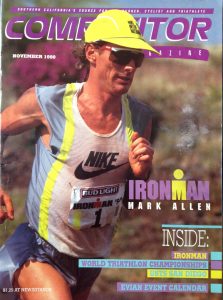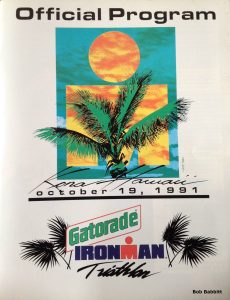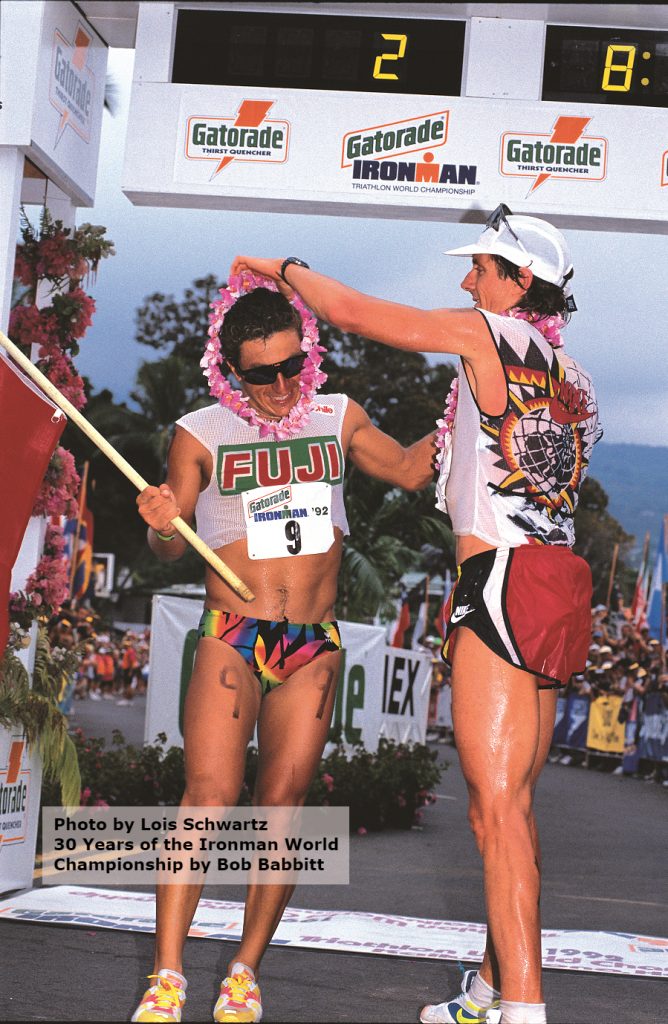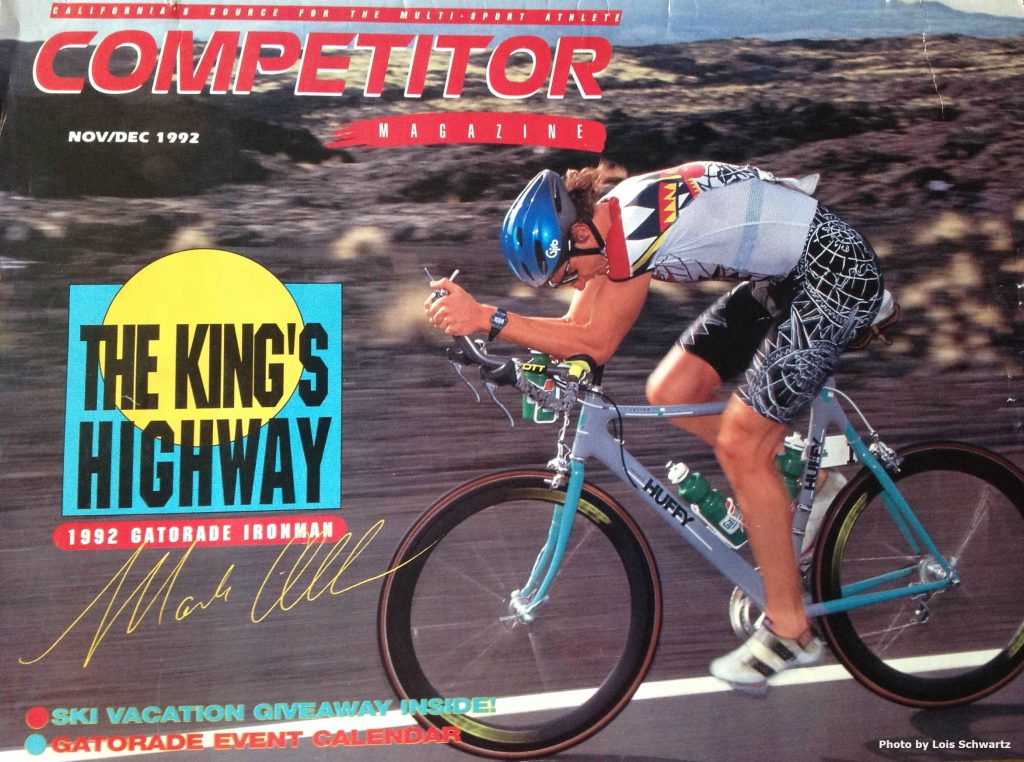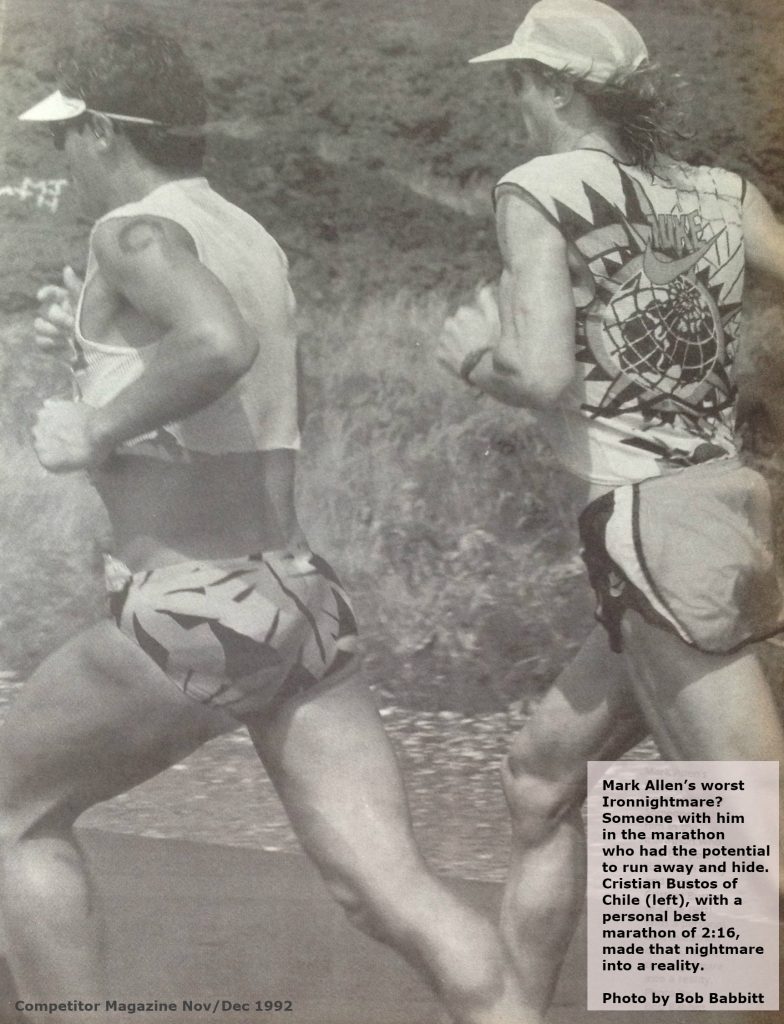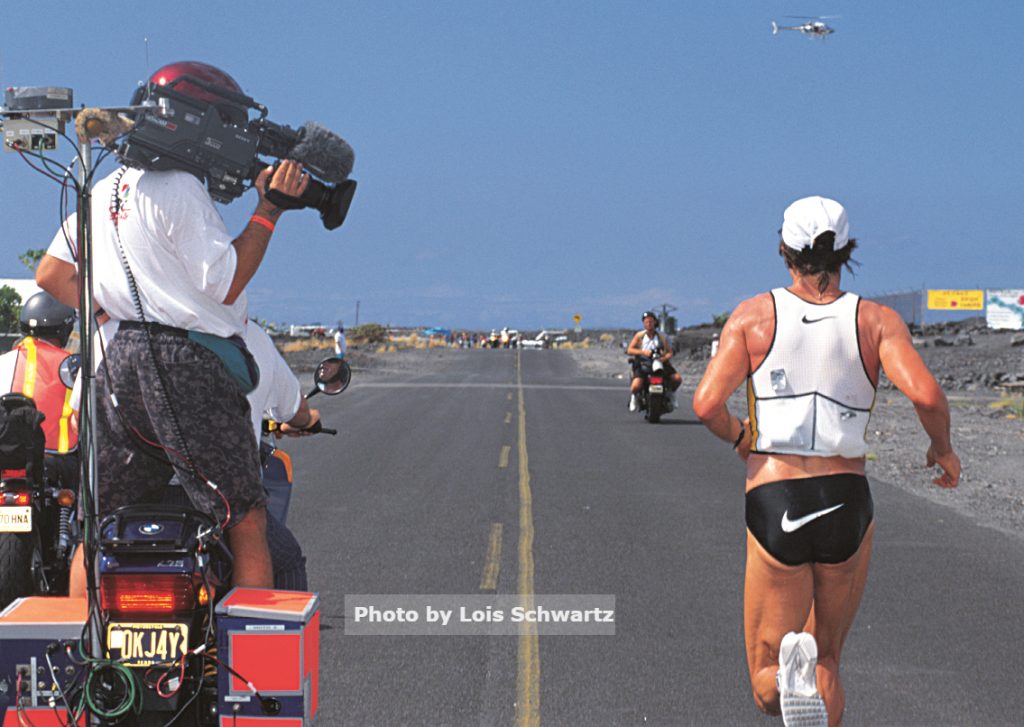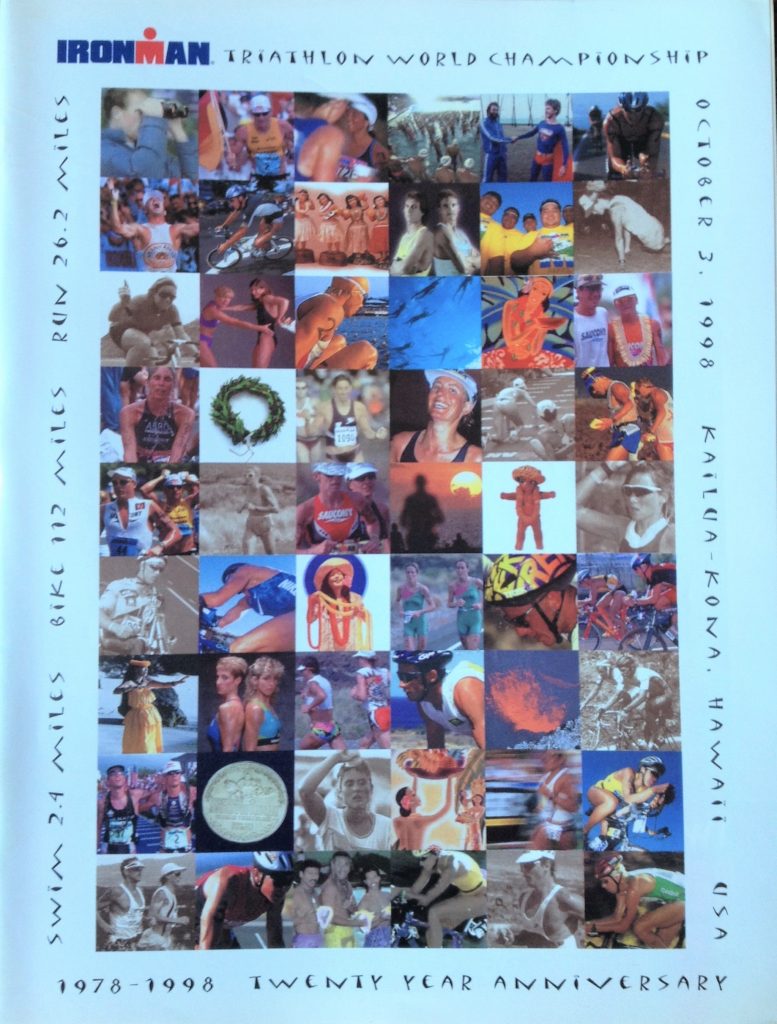2018 is the 40th anniversary of the Ironman World Championship, and I’m looking back at each of my years at the Hawaii Ironman, starting in 1980 on the island of Oahu. I missed the first two years, 1978 and 1979, but since 1980, I haven’t missed a World Championship. Enjoy this count down each year – from my experiences as a participant in the early 80s, to my early years covering the event as a journalist, through my many years covering the race at Competitor Magazine and publisher of the official race program, to the early days of the Ironman LIVE broadcast, and on up to the launch and continuation of the Breakfast with Bob show.
Part 2: 1990 – 1999
1990
After the drama of the Iron War race in 1989, in 1990, the drama came largely from the Big Island and the race day conditions. It was one of those brutal weather days, that took its toll. When I wrote about the race in Competitor Magazine, I titled my article: The Equalizer. At the Hawaii Ironman, you can have the greatest athletes in the world at the peak of their game, but the heat and wind can be the great equalizer. After several years of relatively mild conditions, in 1990 the island threw everything it had at the 1,300 athletes.
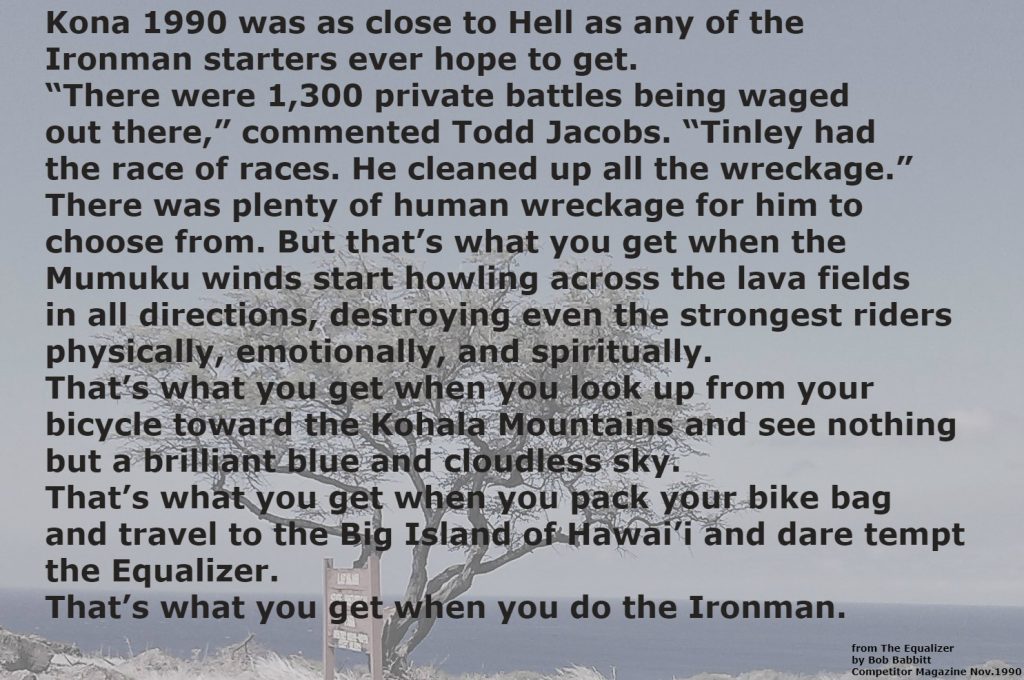
Leading into the race, we featured Erin Baker and Paula Newby-Fraser on the cover of Competitor Magazine. In their 1990 race, Erin took the win, out swimming, biking, and running Paula to get her 2nd victory in 9:13:42.
Mark Allen’s 8:28:17 winning time was nearly 20 minutes slower than his 1989 time, but he still had a day’s best 2:52:48 run. But the best performance of the day went to Scott Tinley, who finished only 40 seconds slower than his time in 1989, and ran 2:53:30 (his fastest ever in Kona) to finish in 2nd place.
As Todd Jacobs said: “The rest of us worry about the conditions. Dave [Scott] and Tinley can race in Hell.”
1991
In 1991, Mark Allen won for the 3rd year in a row, this time battling it out with a young Greg Welch. Paula Newby-Fraser also continued her incredible performances at the World Championship, getting her 4th title, beating her Iron Rival Erin Baker, after finishing 2nd to her in 1990.
1991 was also the year Lois Schwartz and I started publishing the Ironman race program.
In my 30 Years of the Ironman Triathlon World Championship coffee table book, I wrote about Mark and Greg’s race. Greg went in to the race feeling confident and ready to go head-to-head against Mark. I titled the story: Checkmate. Here’s an excerpt:
The two are locked together in mortal combat. Sweat beads up on both foreheads as they survey the board and scan the memory banks. They search endlessly, desperately for the back breaker, the killer, the pièce de résistance… the mother of all moves.
Pawns, rooks, and castles are all willingly sacrificed for the win, the only goal that matters. When you are on the other side of the table, the pause, that calm before the storm, can seem like forever. A deep breath is taken and “The Move” is finally made. A smile plays at the corner of the lips of the mover and the word that always follows the mother of all moves is spoken loudly and clearly, ending the game, ending the speculation, ending any what ifs. So goes the game of the Ironman.
In the game of Ironman chess, sometimes the moves are so subtle no one seems to notice. But they’re there. Letting Greg Welch dictate the pace on the bike took that responsibility off Mark Allen’s shoulders. It also put his most dangerous competitor right where he wanted him most: smack dab in his sights. No worries like, “Where is that guy?” or, “How far back is he?”
Allen played the Ironman chess game to perfection for the third time in a row. But he also knows that only three people have ever run a sub-2:50 in Hawai’i: Allen, Dave Scott…and Welch. Even though he had to stop and stretch for who knows how long this year, Welch still ran 2:48:10.
So don’t count the young Aussie out, Ironman fans. He’s learned a few lessons from the Ironmaster. Both Allen and Welch know that this year is history, that the next time around they’ll start from scratch, that they’ll be playing Ironman chess all over again.
It won’t take Welch many moves to turn Checkmate into Check….Mate.
1992
In 1992, Paula Newby-Fraser out swam, out biked, and out ran the competition to win her 5th world title in a course-record 8:55:28, over 30 minutes faster than 2nd place.
Mark Allen went into the race with a cautious eye on Greg Welch and Pauli Kiuru, but soon realized his greatest rival that day would be Cristian Bustos. The two ran side-by-side until just past mile 14, with Bustos giving Allen his toughest battle since Dave Scott in 1989. When it was all over, Allen waited to congratulate a formidable opponent at the finish line.
After covering the race that year, I wrote about Allen and Bustos for our Nov/Dec issue of Competitor Magazine:
One-on-one racing evolves over time in a long race like the Ironman. One move, then another. Allen likes to test his opponent’s resolve on Pay & Save Hill about nine miles in. With the wind at the runners’ backs, the heat can be stifling.
Bustos didn’t budge.
The stark nothingness of the lava fields awaits the runners after a left turn at the hill’s summit. The crowds diminish and self-doubt flourishes. The cheering of the spectators along Ali’i Drive is a distant memory. That was miles ago. Now there are only telephone poles that go forever, aid stations that are too far apart, endless empty black lava and the sound of your feet hitting the scorched pavement. If your inner resolve isn’t rock solid, the lava fields will crack you like a peanut……
“It’s funny,” says Allen. “But in a race of eight hours, it usually comes down to one moment, to a few footsteps. It’s a matter of knowing when to make those footsteps count.”
1993
In honor of the Ironman’s 15th anniversary, we featured Dave Scott, Mark Allen, and Paula Newby-Fraser on the cover of the race program, a great photo from Melanie Carr. Inside, I wrote about the trio and the 15th anniversary….
15 Ironman races, 15 Ironman victories. Dave has six, Paula has five, and Mark has four. The three have made their names and built their reputations on the Kona Coast. Dave Scott, the comeback kid, is the first inductee into the Ironman Hall of Fame. Paula Newby-Fraser broke down time barriers and became one of the best-known and best-paid women in sports today. Hard luck Mark Allen, who won virtually every other race he entered, finally won the Ironman on his seventh try in 1989 – and he hasn’t lost since.
The Gatorade Ironman Triathlon is rich in history, and memories. In 1978, Navy Commander John Collins staged the first Ironman on Oahu. Gordon Haller won in 11:46:58. Tom Warren’s win in 1979 was covered by Sports Illustrated and captured the attention of the sports world. Then-owner Valerie Silk took the race to Kona in 1981 and changed the race date to October. The 15,000th entrant will jump into Kailua Bay on October 30th, 1993.
1994
1995
Was it the most dramatic day of Ironman racing since Julie Moss and Kathleen McCartney in February of 1982? It just might have been. In 1995, Germany’s Thomas Hellriegel had a spectacular day and out-split Mark Allen, the five-time champion, on the bike by about 17 minutes, 4:29:37 to 4:46:35. Allen was so far behind he contemplated calling it a day as he ran past his condo. “I’ve won this race five times,” he said to himself, “and the condo is right there.” After taking 1994 off, he wondered if, at the age of 37, if he still had what it took to make up over 13 minutes on the young German in the marathon.
After calming his mind and simply putting one foot in front of the other, Allen put together one of the greatest come-from-behind wins in Ironman history by running a 2:42:09 marathon and catching Thomas Hellriegel with just a few miles left to go.
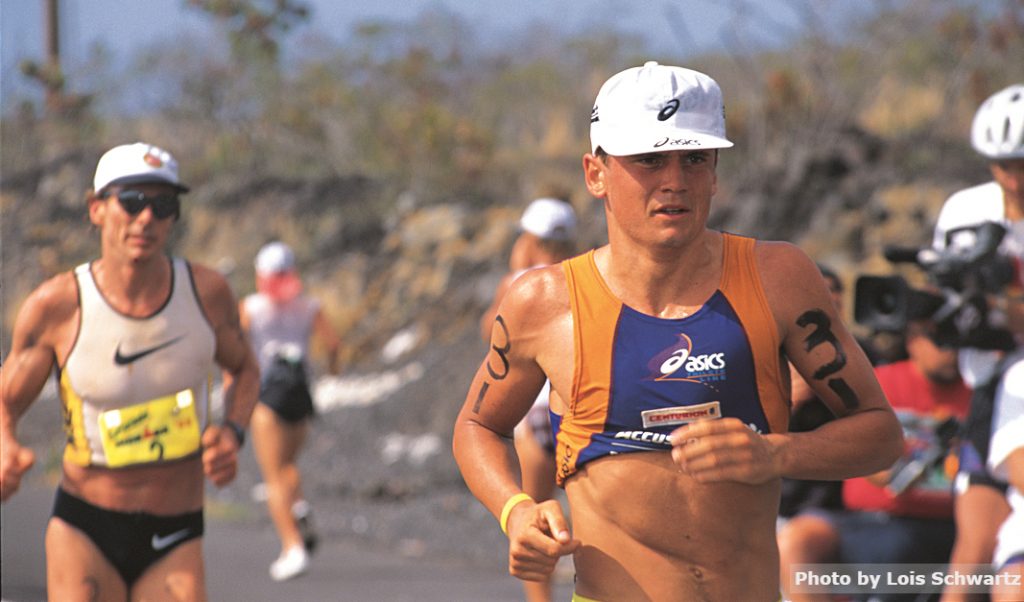
Paula Newby-Fraser was on her way to a typical Queen of Kona Ironman World title: blow the field away on the bike and then cruise the marathon. But 1995 would prove to be different and it would prove to the triathlon world that even the world’s best can melt down on the world’s biggest stage.
Newby-Fraser felt the pressure from Karen Smyers and simply did not eat and drink enough during the marathon. With less than a half mile to go, Newby-Fraser proved that she was indeed mortal and she simply ran out of gas. Karen Smyers ran by her for the biggest win of her career while Newby-Fraser, the ultimate professional, eventually composed herself and ended up walking to the finish in fourth place. Her eighth title would have to wait.
Paula Newby-Fraser had won in Kona seven times. The year was 1995 and, as usual, she built up a huge lead during the bike ride and looked to be on her way to win number eight. But something interesting happened on her way to the finish on Ali’i Drive. Newby-Fraser panicked during the marathon and stopped taking in nutrition. With about a half mile to go, the wheels came off the Newby-Fraser Express and Karen Smyers ran by her for the win, as Newby-Fraser staggered and then collapsed. After getting some fluids in, she walked to the finish in fourth place.
The most decorated Ironman in history showed that she was mortal.
1996
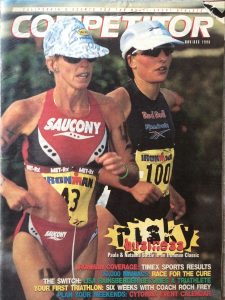
During the latter part of the marathon, she was running with Iron Rookie Natascha Badmann. “I was enjoying myself,” said Newby-Fraser. “I knew that I was a good runner, so why not change things up a bit and try to win the race on the run rather than on the bike?” And that’s what happened. Newby-Fraser ended up winning her eighth and final title by flipping the script and ditching her tried and true win the race from the front formula.
“To be honest,” she insisted afterwards. “I didn’t care if I won today or not. Which is probably why I did.”
1996 was Paula Newby-Fraser’s 8th and final win.
LISTEN to the Babbittville Radio interview with Paula here
1996 marked a transition at the Ironman World Championships: from 1980 to 1996, Dave Scott, Mark Allen, or Paula Newby-Fraser were champions in all but three races (81, Feb 82, and 85). Luc, Thomas, Natascha, and others, were part of the next era of champions.
— Bob Babbitt (@Bob_Babbitt) June 22, 2018
1997
#FlashbackFriday 1997
As we celebrate IRONMAN’s 40th anniversary, I’m looking back at each of my years at the Hawaii Ironman, starting in 1980. This week: 1997. For a storyteller, the 1997 race was a gold mine of incredible stories. I’ll feature a few throughout the day….— Bob Babbitt (@Bob_Babbitt) June 29, 2018
#FlashbackFriday 1997
After two awesome races in 1995 and 1996, that found Thomas Hellriegel finishing in second place, 1997 was the year he reached the top step, and became the first German to win the biggest race in our sport.
More here: https://t.co/ueBNehdWHn
📸Lois Schwartz pic.twitter.com/QtdHSNgVRF— Bob Babbitt (@Bob_Babbitt) June 29, 2018
#FlashbackFriday 1997
We called Heather Fuhr’s win in 1997 Passing of the Torch. Heather passed training partner and long-time friend Paula Newby-Fraser in the run. Despite trying to rally Paula, her day was done….and Heather went on to win the World Championship pic.twitter.com/fEkIEG5M6H— Bob Babbitt (@Bob_Babbitt) June 29, 2018
#FlashbackFriday 1997
After missing the bike cutoff time in 95 & 96, in 1997 John Maclean easily made all the cutoff times and proved that a paralyzed athlete could finish the toughest day in sports, and that anything and everything is possible at the Ironman World Championship pic.twitter.com/iMyP9Aa4ej— Bob Babbitt (@Bob_Babbitt) June 29, 2018
Aussie Chris Legh won north of 60 races in his career including Ironman California & Ironman Coeur d’Alene. But he is best known in Kona for collapsing within 50 yards of the finish line in 1997. Chris is shown here early on the run in 97
📸Lois Schwartz, 98 Ironman Race Program pic.twitter.com/IbLxfiS3mo— Bob Babbitt (@Bob_Babbitt) June 29, 2018
#FlashbackFriday
In 1997, the finish line drama also included what I called The Crawl Part 2 in our 2016 Kona Countdown…. pic.twitter.com/rQUMUG0ImE— Bob Babbitt (@Bob_Babbitt) June 29, 2018
#FlashbackFriday 1997
In a year filled with incredible stories, the 1997 Ironman had one of the most emotional stories ever…
Emily: the story of a very special little girl and the family that she never left 🦋https://t.co/d2rUFp0M5u— Bob Babbitt (@Bob_Babbitt) June 29, 2018
1998
1998 was a brutal wind year. How windy? 1996 champion Luc Van Lierde: “The easiest wind today was worse than the toughest wind in 1996.”
Natascha Badmann and Peter Reid were victorious over the conditions and over the field to each claim their first world titles, with more to come.
1998 was the 20th anniversary of the Ironman, and we featured a collage of classic images on the race program.
And at the awards banquet, race sponsor Isuzu presented the champions with a car for the year (and a really big key).
1999
In 1999, Canadian Lori Bowden became the first woman to run a sub-three-hour marathon at the Ironman World Championship, 2:59:16, and won her first of two world titles.
📷Lois Schwartz
2/5 pic.twitter.com/ONYNmtq0Am— Bob Babbitt (@Bob_Babbitt) July 13, 2018
In 1999, Belgian Luc Van Lierde won his second Ironman World Championship, with Peter Reid in 2nd, a switch in places from their finishes in 1998.
📷Lois Schwartz
3/5 pic.twitter.com/S0JVqXFmyp— Bob Babbitt (@Bob_Babbitt) July 13, 2018
From 1999
Out on the Queen K, an encouraging moment between (then) husband and wife, from one champion (Peter Reid) to another soon-to-be champion (Lori Bowden), captured by Robert Oliver.
4/5 pic.twitter.com/1DtSHZKocs— Bob Babbitt (@Bob_Babbitt) July 13, 2018





